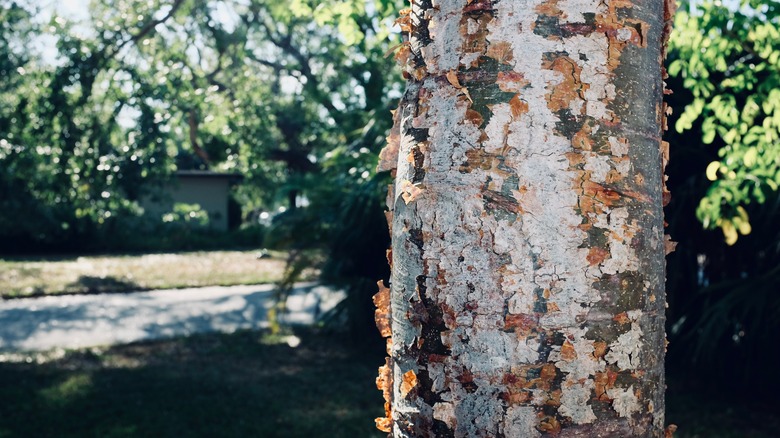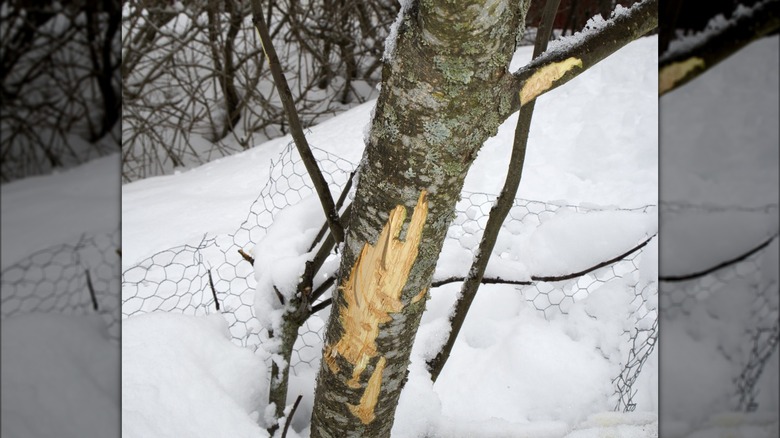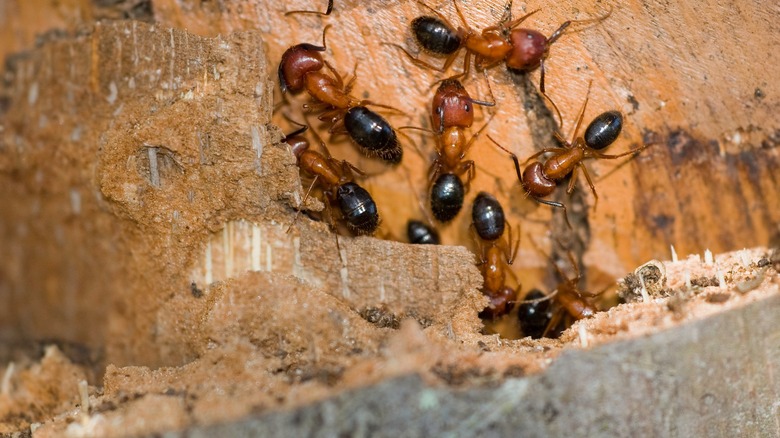What It Means If Your Tree Starts Shedding Bark
Tree bark is akin to armor for the living sentinels gracing your landscape, vital for shielding the trees' food- and water-transporting parts (xylem and phloem) and regenerative issues from injury, So, naturally, the abrupt sight of them peeling, splitting, and coming off of the tree can be alarming — unless you've planted birch, silver maple, American sycamore, shagbark hickory, or other similar trees that shed their barks frequently. As trees age, they grow new, smooth, and flexible tissues, pushing against the old, inelastic bark, causing it to splinter and fall off. These cracked fissures reveal the maturing inner bark, like redbuds flaking off to display orangish-brown layers, ensuring the tree thrives.
However, be on your toes if the peeled areas expose the heartwood or if the branches and trunk are teemed with vertical splits, as these may imply the tree is diseased, stressed, or wounded. A mechanical injury from a car or an errant lawnmower can dislodge the old bark, forcing the tree to cover the injured area with callouses, called woundwood. Avoid sealing the wounds with paint or tar, as they delay recovery. Instead, carefully strip out the remaining loose bark and allow the tree to heal. Remember, you can tape the strips back if the damage is fresh. Continue watering your trees to encourage recovery.
Environmental stressors at play
Severe temperature fluctuations can be a killjoy for young and thin-barked trees. During the winter, the bark may reactivate upon receiving the sun's heat only to refreeze when dusk rolls in, suffering from sun scalding. Such cycles make the tissues dry, weak, and brittle, causing trees' southwest-facing sides to develop long, sinking, dead clefts, and fractures. This significantly diminishes plant vigor, leading to girdled trunks and premature death. Prevent this by covering the trunks with tree guards or burlaps in the fall and allowing the lower branches to overwinter. Irrigate them diligently to negate water stress, especially in the initial growth phase (up to five years).
Conversely, a weak tree can become an easy target for frost damage. Unlike a healthy tree whose tissues remain unaffected during frequent freeze-thaw cycles, their frail counterparts develop vertical faults in their bark and boughs in tandem with mercurial drops. By the time they reseal (after the temperature rises), they'll have become hotbeds for pesky insects and pathogens. Unfortunately, there's no way to redress the frost-cracking issue. Trees may also develop elongated bark splits when lightning strikes deep into their xylem. Hire an arborist to assess the damage, lest the tree collapse, damaging your home or garden.
Pathogens and pests wreak havoc
Despite not being the primary culprits, pests and disease-causing microorganisms, such as boring insects and hypoxylon cankers, may trigger bark shedding in trees. Their usual modus operandi is to invade an already sick or wounded tree and eat away its trunk tissues. Alternatively, you may come across egg galleries neatly lined up in the internal bark layers. This jeopardizes trees' functioning, inhibits vascular movements, and causes stem dieback, cutting their lives short. The only remedial solution is to address the underlying issues. Overwatering, drought stress, or extreme temperature changes are common reasons.
Don't confuse the damage for saprophytic fungi (smooth patch disease) that shelter in and decompose the already dead bark tissues. Compared to the brown, black, or red lacerations common in other fungal infections, they cover the trunk of trees, like oak, elm, and maple, in light gray blotches. Luckily, these fungi are skin-deep and don't threaten the tree's health. Sometimes, your trees may also fall prey to hungry critters, like rabbits and voles, that tear down the bark for food, leaving girdling tissues in their wake. Bucks cause bark splinters — around 1 ½ and 3 ½ inches above ground — when they brush against the trunk to get rid of velvet on their antlers. However, it's mostly restricted to new trees (less than 3-inch-thick trunks), as their soft trunks can't bear the pressure. Bucks, too, cause bark splinters by brushing their antlers against the trunk to get rid of velvet. However, their damage is most common on new trees (less than 3-inch-thick trunks), at around 1 ½ and 3 ½ inches above ground, as their soft trunks can't bear the pressure. Establish exclusionary barriers to keep the pests out. But if they've already caused extensive damage, replace the trees.


